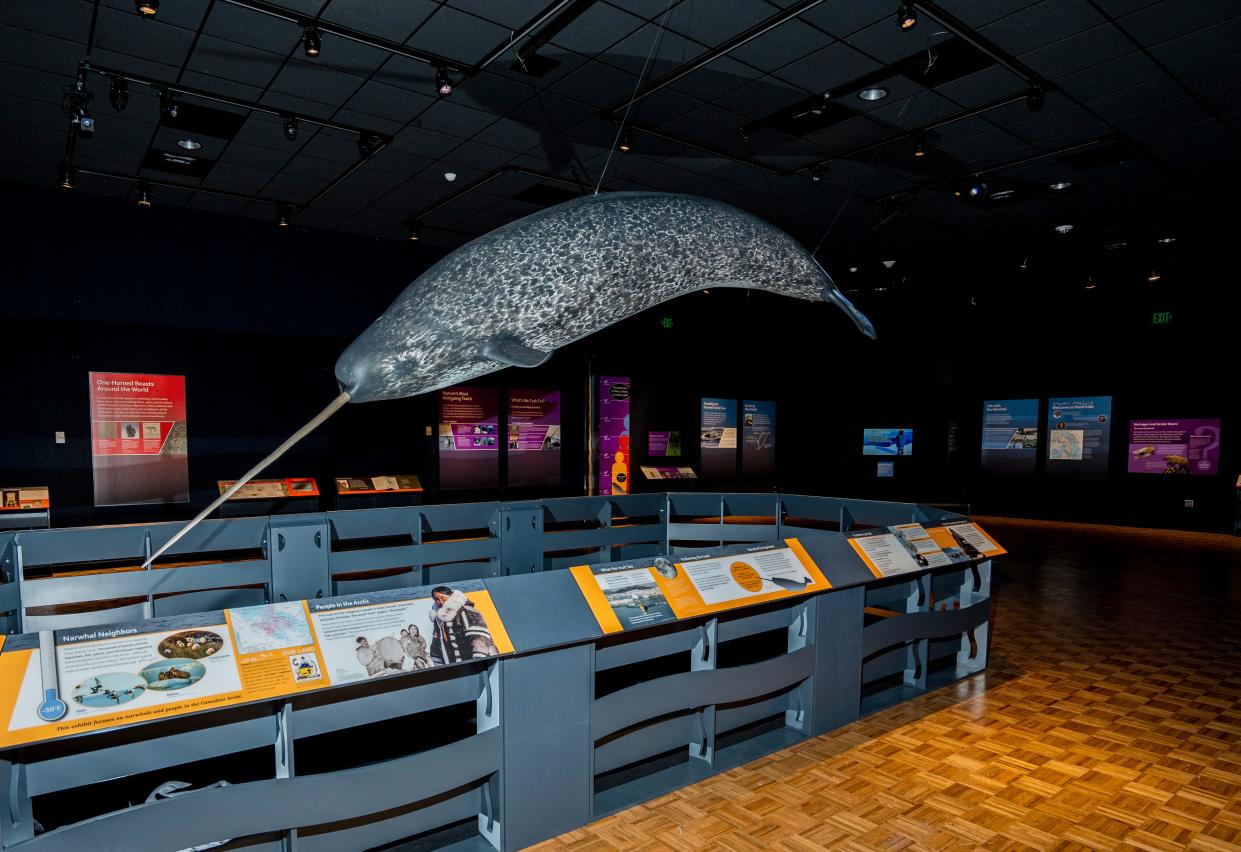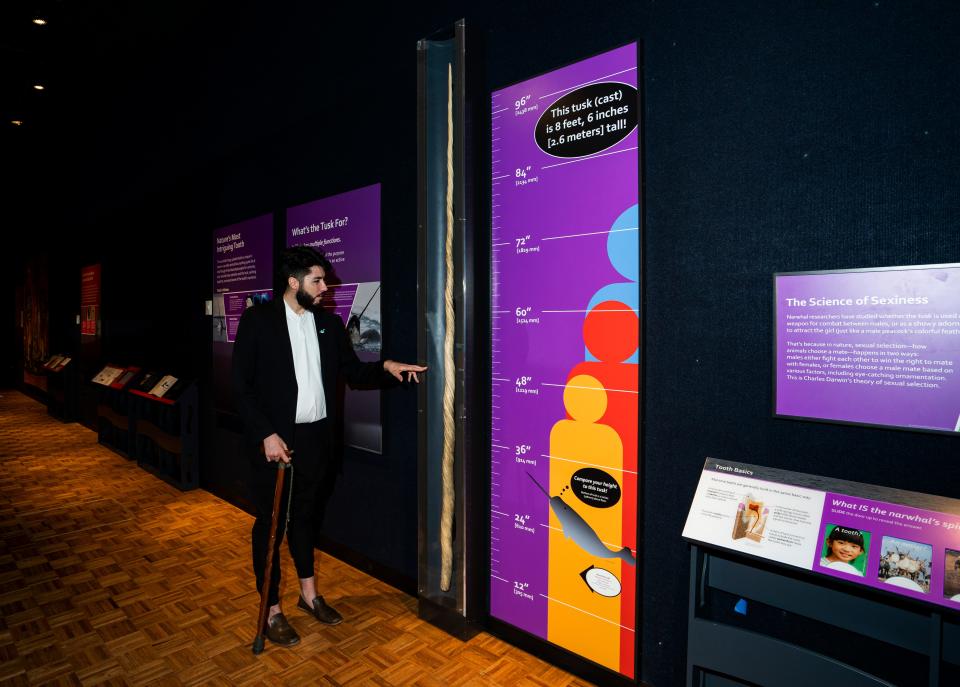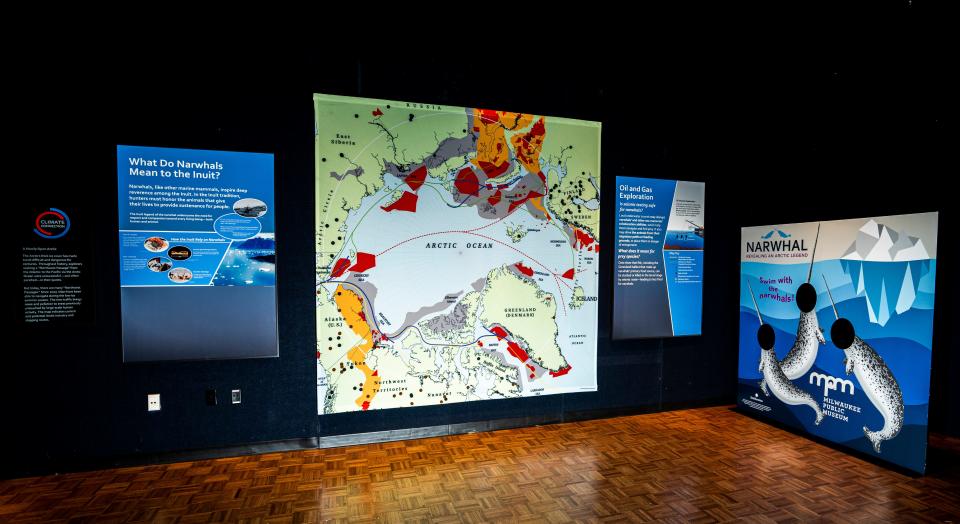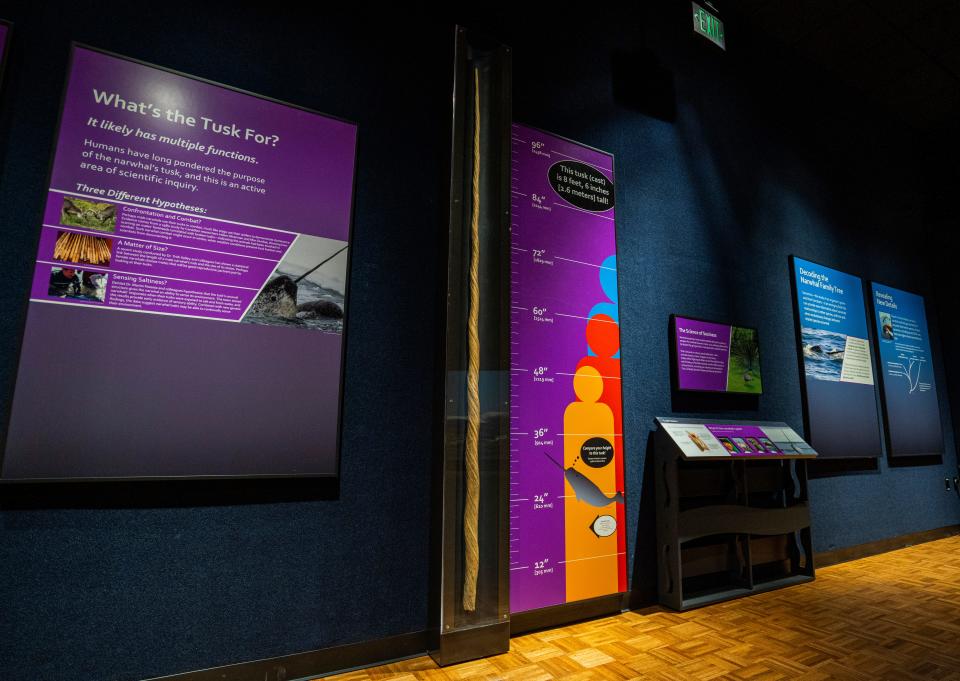Don't know much about narwhals? That's OK. Engaging new museum exhibit shows scientists are learning, too.

It’s got a single tooth – one that shoots straight out of its head.
But this tooth isn’t used for chomping and chewing. It's more like a spear.
And much like the creature itself, it's a thing of mystery.
The narwhal is an animal of legends, scientific debate, and popular T-shirts. And it is largely misunderstood.
But beginning last weekend, the Milwaukee Public Museum is shining a spotlight on the "unicorn of the sea."
The traveling Smithsonian exhibit — "Narwhal: Revealing an Arctic Legend — explores the mythology and science behind one of the world's most esoteric sea creatures.
The exhibit includes a life-sized model of a male narwhal, audio recordings of narwhal clicks and whistles, and interactive displays.
But more than anything, this is a holistic exhibit, said Aaron R. Atencio, curator of cultural sciences at the Milwaukee Public Museum. Atencio, who has a doctorate in anthropolgy, said it’s designed to showcase the "intersection of nature and culture," with the narwhal at the nexus.
Nature's most perplexing tooth
The narwhal's most famous feature – that incredibly large tusk – is actually a tooth.
This 9 foot long tooth is the only tooth a narwhal grows — and it will keep growing for the duration of its life. It’s always the left canine tooth that shoots through the gums, straight out of its snout.
But of course, “since this is nature,” Atencio said, “there is an exception to the rule.” One of every 500 male narwhals will grow two. And in the rarest case – just a single recorded occurance – a female will grow one.
Museum visitors can directly interact with nature’s most famous tooth. The exhibit features a cast of a narwhal tusk, with height measurements displayed on the wall alongside it. Visitors can stand next to the full-scale tooth to see for themselves just how tall this tooth is – and how where they rank in height compared to it.
Looking at the tooth closely, people can also observe its intricacy: The tooth grows spirals in a counterclockwise pattern. Atencio said that “provides strength,” as well as flexibility — it can bend up to 12 degrees in any direction.
So why did nature give the narwhal such an outrageously long, flexible tooth? And why give it only one that happens to grow straight out of its head, off to the left?
The short answer is: Scientists aren’t quite sure.
There are several theories, some which explain its evolutionary history and some that suggest possible functions.
The consensus is that the tusk has served evolutionary purposes similar to a stag’s horns: Big tusks signify the fittest mates.
As Atencio explained, peacocking and mate selection is “a good theory to start from.”
But there is one key outlier.
With over 2 million nerve endings, the tooth is really quite sensitive. That indicates something else might be going on.
“Think about how bad it is when you crack a tooth,” Atencio said.
One hypothesis that the museum highlights comes from a 2014 study. The study found that the tooth may function as a sensory system. While the results of the study are not unanimously accepted, there is reason to suggest it is part of a complicated perceptual system.
Bottom line: Scientists are still learning.

'Reimagine' the scientific method
Scientists are so perplexed by the narwhal in part because it is difficult to study.
Researchers can’t simply capture one and create a controlled study. “Trapping an animal puts them under stress,” Atencio said, and narwhals are particularly prone to difficulties in these situations; in fact, he said, narwhals can't survive in captivity.
One alternative is to observe them in the wild. But scientists are typically in narwhal territory — Arctic regions around Canada and Greenland — for just a few months at a time. That's not enough to get a complete picture.
As a result, the science needs to be reimagined.
In the Arctic, the Inuit people have lived their whole lives with narwhals and observed their behavior in a shared environment. Their knowledge of the mammal contrasts sharply with what scientists were coming up with studying them short-term. Essentially the scientists were pushing the Inuits aside to do their work. Now, “you're starting to see the origin communities (begin to) lead this research,” Atencio said.
Atencio described how researchers have come to rely on integrating traditional knowledge with knowledge from origin communities, and this pivot has proved to be essential for moving the field forward.
Rebecca Ehlers, the Milwaukee museum's vice president of marketing, communications and visitor experience, described the rich narwhal knowledge that origin communities have.
She explained, as an example, that visiting scientists had historically counted narwhal pods using airplanes. This worked for spotting narwhals right on the surface, but the method missed something else entirely.
It wasn’t until scientists involved the Inuit communities in their data collection that they learned that narwhals swim in layers, congregating in pods of one hundred or more.
The Inuit people knew about these layers by living among the narwhals. “That's where that scientific research and the origin community knowledge really helps us understand more about narwhals," Ehlers said.

Science is storytelling
Atencio further explained that scientists and origin communities are beginning a collaboration between storytelling and scientific exploration.
As a researcher, Atencio believes that storytelling and myths should be looked at as a different form of science — and a legitimate way of understanding natural phenomena.
For Inuit communities, the narwhal is understood through a myth. "It's a story about kindness. And how to be good towards each other,” he said.
The narwhal legend tells the story of a boy and his mother. The young boy was blind, and his mother was “always down on him.”
One day, he went on an excursion. When he harpooned a large narwhal, his mother got tied up on the harpoon and was yanked down into the water with her hair tangled around the harpoon. And that’s how the narwhal got its tusk, Atencio said.
Atencio explained that these myths are oral histories, and they function as “a way to make sense of and show reverence for the environment.”
It’s this interaction of science and oral history that he said is one of the main “precursors” towards viewing science as storytelling.
He described how exhibits like this one provide an opportunity to “tell the stories…that don’t necessarily fit within the (traditional) scientific paradigm."
A global ecosystem in crisis
One key aspect the Museum exhibit explores is how climate change — and the human contribution to climate change — is impacting narwhals and the Arctic ecosystem.
When narwhals migrate, they return to areas with familiar ice patterns. But climate change has caused ice formations to suddenly shift, putting narwhals at risk of getting trapped below the ice and dying of suffocation.
He said that while humans are detached from direct effects of climate change — “We're not under ice, right?" — the effects on the environment are very real.

Shifting the scientific conversation
To get the public engaged in complex concepts like climate change, Atencio said that exhibits like this one are meant to “build a bridge” between different interests and research areas.
“What we want to do is create exhibits where we engage people and they can do their own research and come to their (own) conclusions and see what really matters to them,” he said.
Ehlers sees the exhibit as giving "some real examples of something that's happening very far away," but that humans are still contributing to, she said.
Atencio hopes the exhibit will help visitors understand that “we, as a scientific institution, aren't the cornerstone of understanding.” In other words, scientists do not — and cannot — have all of the answers.
What scientists “really need (is) to rely on these origin communities,” he said. Building an exhibit like this one would be impossible without their knowledge.
Science, he said, is going to look different when more voices join the conversation.
Our subscribers make this reporting possible. Please consider supporting local journalism by subscribing to the Journal Sentinel at jsonline.com/deal.
DOWNLOAD THE APP: Get the latest news, sports and more
This article originally appeared on Milwaukee Journal Sentinel: Milwaukee Public Museum narwhal exhibit explores myths, mystery

